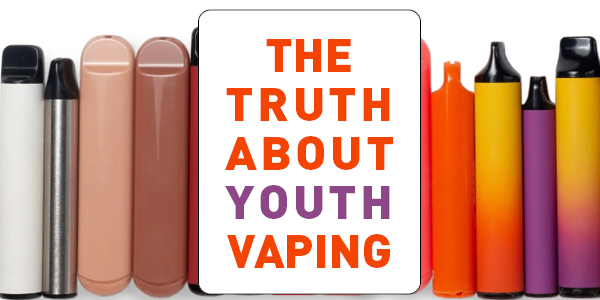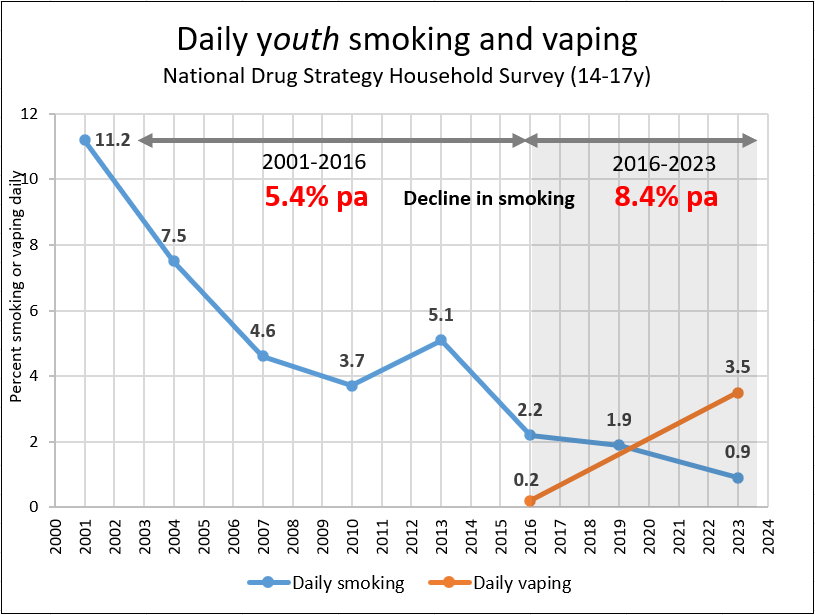
Youth vaping. Is it time to panic?
Posted on March 1, 2024 By Colin
THE HEALTH MINISTER typically refers to youth vaping as a crisis. You could be forgiven for thinking kids were dying in the streets and the sky was about to fall in. However, the data from the recent 2022/23 National Drug Strategy Household Survey (NDSHS) and the scientific evidence tell a different story. Regular youth vaping in Australia is rare and is reducing deadly smoking.
To be clear, kids who don't smoke should not vape. However, public messaging about vaping should be accurate. Much of it is not.
Vaping is diverting young people from smoking
Mr Butler said this week, that vaping is leading young people to take up smoking. "Tragically, the only cohort in our community where cigarette smoking is on the rise is the youngest members of our community." This is incorrect. The data from the NDSHS show that as vaping increases, the decline in youth smoking has accelerated.
Smoking rates by 14-17-year-olds plummeted 53% from 1.9% to 0.9% in 2023
The daily youth smoking rate fell over 50% faster since vaping became available in 2016. From 2001-2016 the rate of decline was 5.4% per year. After 2016 the rate of decline was 8.4% per year.

Rather than being a gateway to smoking, it is now clear that vaping is diverting smokers and would-be smokers away from the deadly habit. This is a huge public health victory.
How frequently do kids vape?
Most young non-smokers who vape do so infrequently and transiently. Of the 28% of 14-17-year-olds who have ever tried vaping, half (14.2%) do so only once or twice. (Table 3.9) An additional 7.3% have tried and stopped vaping. (Table 3.9)
Only 3.5% vape daily (Table 3.9)
Some of these are former smokers or never-smokers who may have taken up smoking if vaping was not available. For this group, vaping is likely to be very beneficial.
9.7% of kids are current users who have vaped once or more in the last month. Some would be former smokers and many would be very occasional users. However, some vape more often and may be at some risk if they continue vaping for some years.
How harmful is youth vaping?
Only frequent vaping over the longer term has the potential to cause harm, and serious harmful effects to date are very rare. (Evidence Review 2023)
There is no clear evidence that vaping causes “functionally important” respiratory symptoms. Youth vaping is not linked with the onset of asthma (although smoking is).
Vaping nicotine does NOT cause seizures or pneumothorax (lung collapse). There is a very rare risk of burns from lithium-battery explosions, a risk from all devices that use these batteries, such as mobile phones and laptops,
Some young vapers who had never smoked are getting positive benefits from vaping that may outweigh any small risks, such as pleasure, relaxation, weight loss, improved ADHD and schizophrenia.
How common is nicotine dependence?
The Health Minister claims that vaping is addicting a whole new generation to nicotine. This is not true.
9.7% of 14-17-year-olds are current users (3.5% vape daily, 6.3% vape weekly or less often - rounded to 9.7%). (Table 3.9).

Of these 31% are "unable to stop or cut down the use of e-cigarettes" and are probably "addicted". (Table 3.25)
This leaves 3% of 14-17-year-olds who may be "addicted", not "a whole generation"
Of these, some would have been smokers and were already nicotine dependent before vaping.
Nicotine dependence can lead to withdrawal causing short-term symptoms such as irritability, restlessness, anxiety, difficulty concentrating, and depression. These symptoms are unpleasant but not serious.
Otherwise, nicotine itself is relatively benign. There is no evidence it harms human brain development. It does not cause cancer or lung disease and only has a minor role in cardiovascular disease.
Many studies have shown that vaping is less addictive than smoking.
Access is mostly from family and friends
The Minister justifies his retail sales ban by incorrectly claiming that retail outlets are the source of supply to youth, saying "these things have been flooding in and being sold to kids through vape stores".
However, the NDSHS found that only 15.6% of youth vapers (14-17 years) purchased their vapes from a retail outlet (tobacco retail 8.9%, other retail 6.7%) (Table 3.9)
Seventy-eight percent got supplies from a friend or family member, 6.7% from the internet and 7.2% from a pharmacy.
The ban on retail sales that starts today should be reversed to allow adult smokers to access vapes more easily. Youth access can be reduced by licensing vape shops, CCTV records and harsh fines and loss of licence for underage sales.
Note
Tables refer to the data tables for the NDSHS 2022/23, and can be found here.
Go to Top